Picking The Bottom Of The Property Market - September 2022
September 15, 2022 / Written by Rich Harvey
By Guest Blogger, Pete Wargent,
Next Level Wealth
Bumping along the bottom
What are the primary indicators to suggest that we are approaching the bottom of the property market cycle, and how dependable are these market indicators?
At the micro or local level, the market turning often begins with intangibles…buyers taking more serious interest at open homes, or holding more concerted conversations with real estate agents, more contracts being handed out, and so on.
An active buyer’s agent will notice these subtle trends before anyone else does. Mortgage brokers also tend to have a strong handle on market conditions, as they observe changes in borrowing capacity and lending volumes far ahead of them being reported.
Eventually the uptick in activity begins to be reflected in the formal indicators reported in the media, such as auction clearance rates, falling days on the market, and all the rest.
The bottom is a process, not an event
Every cycle is different. Sometimes there are obvious triggers for the market turning around, such as the 2019 election result and announcement of the results of the financial services and banking Royal Commission, for example.
But more commonly the ‘bottom’ of the market is a process rather than an event; and often the bottom of the market isn’t apparent until after the event.
Buyers tend to be forward-looking, and at some point the unwelcome news and market information is all factored in. And then with the vast intergenerational wealth that’s been built up in Australia over the decades the bargain-hunters begin to reappear.
Prices then stabilise, and as the fear subsides more confident buyers return to the market, looking forward to brighter market conditions ahead.
Most often buyers seem to wait for confirmation that the market is rising and all the forward-looking indicators to line up favourably, by which time, of course, the bottom of the market has long since passed, and prices have bounced hard!
The elephant in the room
The key question in the mind of most market participants at the moment relates to how high interest rates might run.
The good news is that an entire range of forward-looking indicators, including market-based measures confirm that inflation is expected to return to the 2-3 per cent target over time.
The more challenging dynamic is that with rents and energy bills still rising headline inflation in Australia isn’t likely to peak until the end of this calendar year; and these are figures which won’t be formally reported until February 2023.
Until that time, interest rates are likely to be ratcheted higher from their current level of 2.35 per cent, with at least two further 25 basis point hikes set to come, taking the cash rate target
back up to around 2.85 per cent. A more hawkish scenario sees the cash rate rising to around 3½ per cent next year.
Figure 1 – Cash rate target
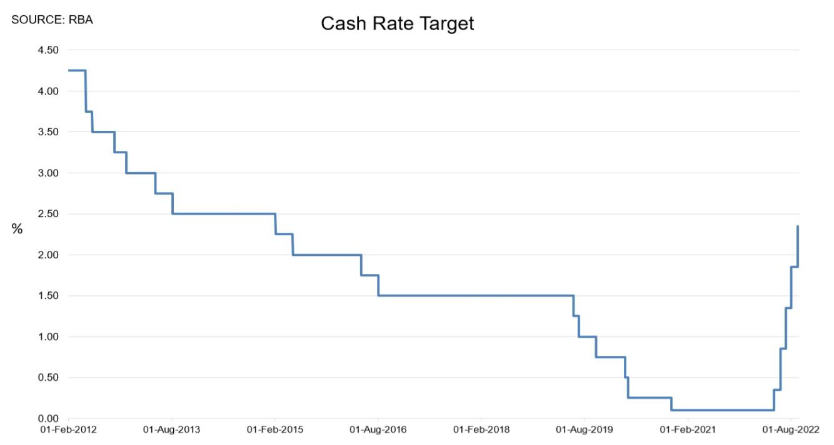
It looks likely that the housing market will bottom out when consumers no longer fear further interest rate hikes, which probably leads to us around 6 months from now.
On the balance of probabilities, the market will most likely bump along the bottom for a brief period of time before starting its rise up again due to obvious pressures with rising rents and massive immigration.
What does history tell us about previous downturns? Mostly that they generally don’t last for too long before supply begins to tighten; and historically, prices haven’t fallen too far in nominal terms before the uptrend resumes.
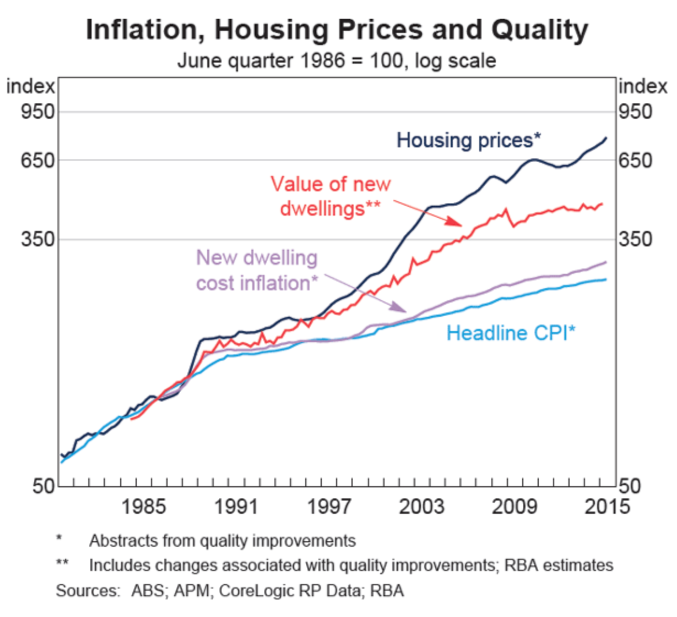
Conflicting voices
Who should you really listen to when there's so much doom and gloom around?
You have a few choices, of course. Your accountant who's typically conservative, your financial planner who often doesn't factor property into the portfolio, or friends at the weekend barbecue.
Or should you consider the experienced buyer’s agent that has boots on the ground, and is seeing exactly what is happening at auctions, at open houses, and the actual transactions as they’re occurring on a daily basis?
From a financial standpoint does it really matter if you pick the exact point to purchase at the bottom of the market? The answer is that the longer you plan to hold a quality asset with a high land-to-asset ratio, generally speaking the less important the exact entry point becomes.
Would you perhaps be better off buying when you have the capacity to buy and riding out the cycles? If you’re a long-term investor the answer is probably yes.
Record demand for rental housing
Rental vacancy rates have now fallen to under 1 per cent at the national level, with extremely tight rental vacancy rates across 6 of the 8 capital cities, and Sydney and Melbourne tightening fast.
The national vacancy rate did fall under 1 per cent on one previous occasion, just over 16 years ago, but we’re heading towards unprecedented territory now.
Figure 2 – Rental vacancy rates
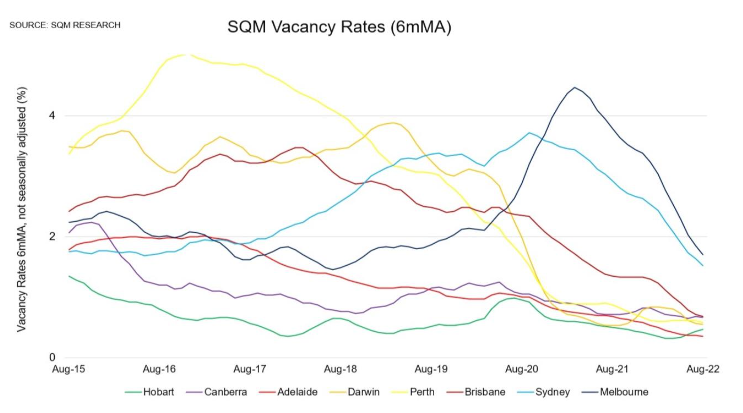
While short-term arrivals into Australia are still way below their historical averages, long-term and permanent arrivals bounced back to over 60,000 in July.
With overseas arrivals shooting up by over 300,000 in the past month and comfortably outpacing the number of departures, this has profound implications for the easing of capacity constraints in the labour market, and of course for the rental market (not least because most new arrivals into Australia are renters).
Figure 3 - Immigration rebounding hard
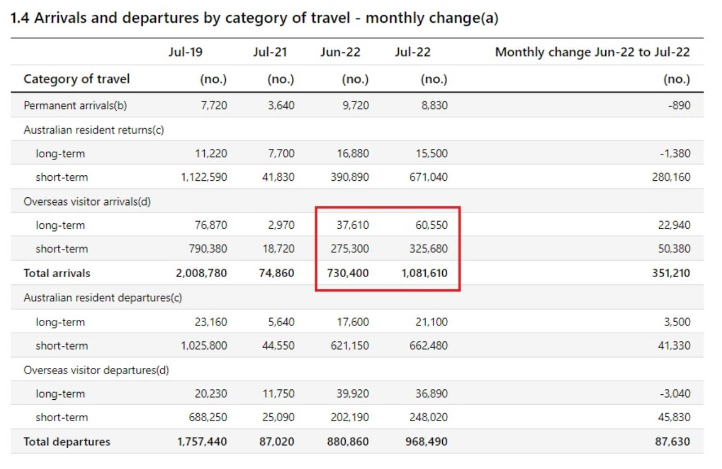
The guys at Macquarie Macro Strategy have an excellent record of picking market turning points, and as they show, this means that immigration into Australia is going to come rocketing back next year.
It’s not at all out of the question that we see record high population growth of more than 450,000 per annum, given that the permanent migration cap has just been lifted from 160,000 to 195,000.
Figure 4 – Net immigration to Australia set to boom
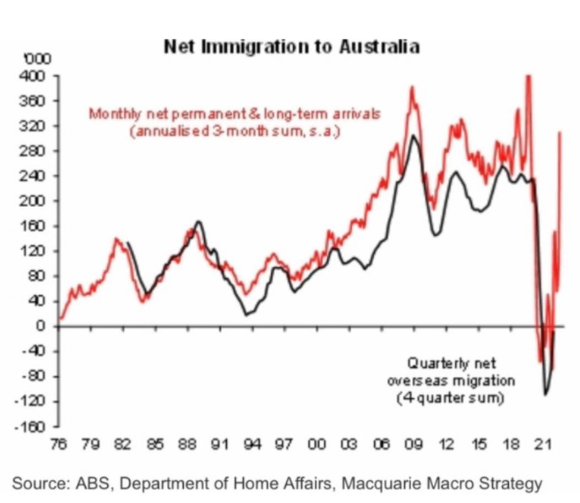
The immigration ramp up has barely even begun, and yet asking rents are already rising at a pace of more than 20 per cent per annum.
On this evidence, rather than trying to pick the exact bottom of the market, it’s more realistic to accept that rebounding population growth is going to steamroller all other macro factors to drive record demand for housing over the next few years.
To have one of the friendly Propertybuyer Buyers' Agents to contact
you in regards to buying property :
call on 1300 655 615 today.









.svg)
.svg)
.svg)

